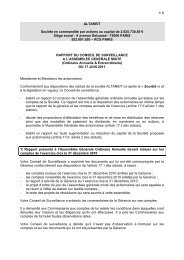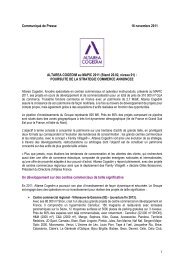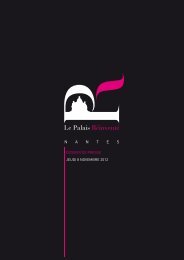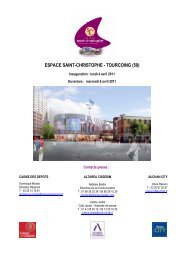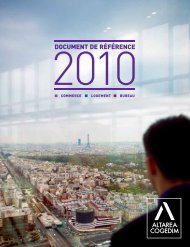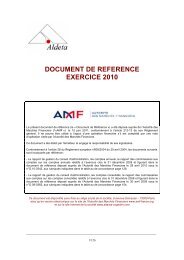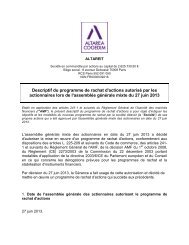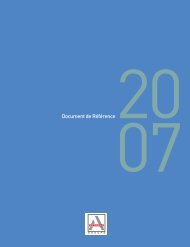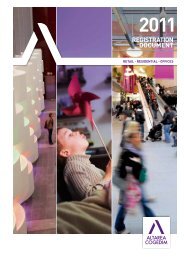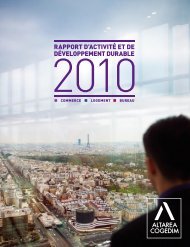Annual report 2008 - Altarea Cogedim
Annual report 2008 - Altarea Cogedim
Annual report 2008 - Altarea Cogedim
Create successful ePaper yourself
Turn your PDF publications into a flip-book with our unique Google optimized e-Paper software.
CONSOLIDATED FINANCIAL STATEMENTS<br />
The definitive allocation of goodwill arising from the<br />
acquisition of <strong>Cogedim</strong> based on the new CGUs had no<br />
material impact on the Group’s financial statements at<br />
31 December <strong>2008</strong>. The level of impairment charges would<br />
have been more or less identical before and after the change<br />
in accounting method.<br />
See note 12 “Impairment of assets under IAS 36” and<br />
section 12.1.<br />
7.4. Preparation of the consolidated<br />
financial statements<br />
The consolidated statements comprise the financial<br />
statements of ALTAREA SCA and its subsidiaries at<br />
31 December <strong>2008</strong>, as well as its interests in associated<br />
companies and jointly controlled entities.<br />
In accordance with IAS 27, exclusive control exists when<br />
ALTAREA has the power to govern the financial and operating<br />
policies of its subsidiaries and also to appoint, dismiss and<br />
summon the majority of members of the Board of Directors<br />
or the equivalent management body. Companies over which<br />
ALTAREA exercises control are fully consolidated. Control is<br />
presumed to exist when ALTAREA directly or indirectly holds<br />
a majority of the voting rights. Effective control exists when<br />
ALTAREA has the power to control the Group’s strategy and<br />
its financial and operating policies.<br />
Subsidiaries are consolidated from the date at which control<br />
is acquired until the date at which control ceases to be<br />
exercised, notably in the event of a disposal.<br />
Subsidiaries’ financial statements are prepared for the<br />
same accounting period as for the parent company using<br />
consistent accounting policies.<br />
Reciprocal items, dividends received from consolidated<br />
companies and profits on intercompany transactions<br />
are eliminated upon consolidation. Only the profits are<br />
eliminated on fees internal to the Group (for delegated<br />
project management, operating management, design<br />
studies, etc.) that are capitalised or held in inventory. For<br />
proportionately consolidated companies, eliminations are<br />
reduced in proportion to ALTAREA’s percentage ownership.<br />
7.5. estimated and assumptions affecting<br />
assets and liabilities<br />
In preparing financial disclosures in accordance with<br />
generally accepted accounting principles, the Group’s<br />
management must make estimates and use assumptions<br />
that affect not only the amounts presented as assets and<br />
liabilities, including contingent assets and liabilities at the<br />
disclosure date, but also the amounts presented as income<br />
and expense for the period.<br />
<strong>2008</strong> brought an economic and financial crisis, the scale<br />
and duration of which could not be forecast beyond the<br />
balance sheet date. Accordingly, management reviewed its<br />
estimates and assumptions on a regular basis using its past<br />
experience and various other factors deemed reasonable<br />
in the circumstances. These represent the basis for its<br />
assessment of the carrying amount of income and expense<br />
items and of assets and liabilities. These estimates have<br />
an impact on the amount of income and expense items<br />
and on the carrying amount of assets and liabilities. It is<br />
conceivable that the actual amounts may subsequently<br />
differ from the estimates adopted.<br />
The main items that require estimates at the balance sheet<br />
date based on assumptions about the future, and for which<br />
there is significant risk of a material change in value from<br />
that recorded on the balance sheet, concern the following:<br />
Measurement of intangible items<br />
– the measurement of goodwill (see notes 7.15, 12.1 and 12.3),<br />
– the measurement of the <strong>Cogedim</strong> brand (see notes 7.16<br />
and 12.2)<br />
Measurements of other assets and liabilities<br />
– measurement of investment properties (see note 7.12),<br />
– measurement of assets under development (see note 7.13,<br />
7.14 and 12.4),<br />
– measurement of customer relationships (see notes 7.10<br />
and 12.5)<br />
– measurement of inventories (see note 7.16)<br />
– measurement of deferred tax assets (see note 7.23 and 15)<br />
– measurement of financial instruments (see notes 7.18<br />
and 13.21).<br />
Operating profit estimates<br />
– the measurement of net property income and services using<br />
the percentage-of-completion method (see note 7.24)<br />
The uncertainties arising from the economic and financial<br />
crisis make it harder to measure assets and liabilities,<br />
income and expense items predicated on assumptions of:<br />
– completion of the business plans used to conduct<br />
impairment tests for goodwill, intangible assets, including<br />
customer relationships and brands, properties under<br />
development and the capitalisation of deferred taxes<br />
– determination of the market value of investment properties<br />
based on an analysis of transactions in a market in which<br />
transactions are fewer and further between,<br />
88



